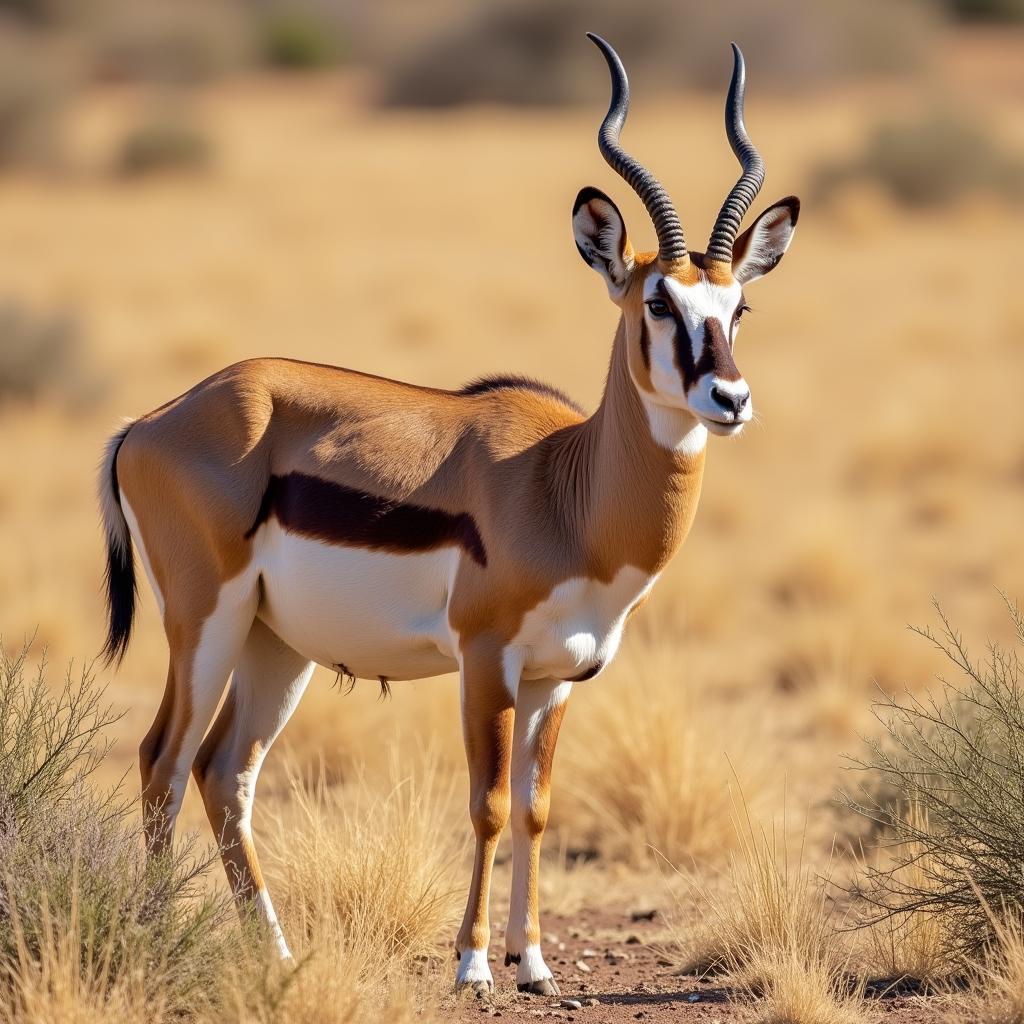The Springbok: An Iconic African Deer-Like Antelope
The African springbok, scientifically known as Antidorcas marsupialis, is a captivating antelope species renowned for its incredible speed and agility. Often mistaken for a african deer like animal, this graceful creature is an integral part of the African landscape. From its distinctive physical characteristics to its fascinating behavioral patterns, the springbok offers a glimpse into the captivating biodiversity of the African continent.
Unveiling the Springbok: Physical Characteristics and Habitat
Springboks are medium-sized antelopes, with males typically larger than females. They are characterized by their:
- Striking coloration: A light brown coat with a distinctive brown stripe running along their flanks, separating the brown from the white underparts.
- Unique facial markings: White face marked by dark brown or black stripes that run from the corner of their eyes down to the corners of their mouth.
- Lyre-shaped horns: Both males and females possess these impressive horns, though those of the males are thicker and longer.
 Springbok grazing in the grasslands
Springbok grazing in the grasslands
Their preferred habitats are the open grasslands and savannas of southern Africa, particularly in countries such as South Africa, Namibia, and Botswana. These dry regions offer the perfect environment for the springbok to thrive, with their adaptations allowing them to conserve water and withstand high temperatures.
A Symphony of Speed and Grace: Springbok Behavior
Springboks are highly social animals, often found in herds that can range in size from a few individuals to thousands strong. This herding behavior is crucial for their survival, offering protection from predators like lions, cheetahs, and leopards.
Perhaps their most iconic behavior is the spectacular leaping display known as “pronking.” When threatened or alarmed, springboks launch themselves into the air with all four feet held stiffly beneath them, reaching heights of up to 3.5 meters. This incredible feat is thought to serve multiple purposes, including:
- Confusing predators: The erratic bouncing movement can make it difficult for a predator to single out an individual.
- Signaling fitness: Demonstrating their agility and strength to potential mates and rivals.
- Warning others: Alerting the herd to potential danger.
The Springbok’s Role in African Culture and Conservation
The springbok holds cultural significance in several African societies. For example, in South Africa, the springbok is the national animal and a symbol of speed, agility, and grace. It is also featured on the emblem of the South African national rugby team, further solidifying its place in the nation’s identity.
“The springbok is more than just an animal; it is a symbol of resilience, determination, and the untamed spirit of Africa.” – Dr. Jabulani Ngcobo, Wildlife Biologist.
From a conservation perspective, the springbok is classified as a species of “Least Concern” by the International Union for Conservation of Nature (IUCN). However, threats such as habitat loss due to agriculture and overgrazing still persist. Efforts are underway to protect this iconic species and ensure its continued survival for generations to come. You can learn more about conservation efforts for other african antelopes list on our website.
FAQs about the African Springbok
1. What is the average lifespan of a springbok?
Springboks typically live for about 10 years in the wild.
2. Can springboks survive without water?
Remarkably, springboks can survive for extended periods without drinking water, obtaining moisture from the plants they consume.
3. What is the main predator of the springbok?
Lions, cheetahs, leopards, and wild dogs are among the springbok’s primary predators.
4. Are springboks endangered?
No, springboks are currently listed as a species of “Least Concern,” but habitat loss remains a potential threat.
Delve Deeper into the African Wilderness
The springbok is just one fascinating example of the incredible diversity found within the african antelope guide. From the majestic kudu to the diminutive dik-dik, each species offers a unique glimpse into the wonders of African wildlife.
If you want to learn more about other african deer thing and the captivating world of African wildlife, explore our website for more engaging articles and insights.
For support, contact us at:
Phone Number: +255768904061
Email: kaka.mag@gmail.com
Address: Mbarali DC Mawindi, Kangaga, Tanzania.
Our customer service team is available 24/7 to assist you.

